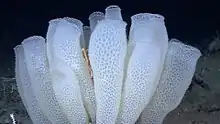Venus' flower basket
The Venus' flower basket (Euplectella aspergillum) is a glass sponge in the phylum Porifera. It is a marine sponge found in the deep waters of the Pacific ocean. As other glass sponges, they build their skeletons out of silica, which is of great interest in materials science as their optical[1] and mechanical[2] properties are in some ways superior to man-made materials. As other sponges, they feed by filtering sea water to capture plankton.[3]
| Venus' flower basket | |
|---|---|
 | |
| Group of Venus' flower baskets | |
| Scientific classification | |
| Kingdom: | Animalia |
| Phylum: | Porifera |
| Class: | Hexactinellida |
| Order: | Lyssacinosida |
| Family: | Euplectellidae |
| Genus: | Euplectella |
| Species: | E. aspergillum |
| Binomial name | |
| Euplectella aspergillum Owen, 1841 | |
The sponges are often found to house glass sponge shrimp, usually a breeding pair, who are typically unable to exit the sponge's lattice due to their size. Consequently, they live in and around these sponges, where the shrimp perform a mutualistic relationship with the sponge until they die. This may have influenced the adoption of the sponge as a symbol of undying love in Japan, where the skeletons of these sponges are presented as wedding gifts.[4][5]
Occurrence
Venus' flower baskets are found in a small area of the sea nearby the Philippine Islands. Similar species occur near Japan and in other parts of the western Pacific Ocean and the Indian Ocean.
Morphology
.jpg.webp)
.jpg.webp)
The body is tubular, curved and basket-like and made up of triaxon spicules. The body is perforated by numerous apertures, which are not true ostia but simply parietal gaps. Syconoid type of canal system is present, where ostia communicate with incurrent canals, which communicates with radial canals through prosopyles which, in turn, open in to spongocoel and to outside through osculum.
The body structure of these animals is a thin-walled, cylindrical, vase-shaped tube with a large central atrium. The body is composed entirely of silica in the form of 6-pointed siliceous spicules, which is why they are commonly known as glass sponges. The spicules are composed of 3 perpendicular rays giving them 6 points. Spicules are microscopic, pin-like structures within the sponge's tissues that provide structural support for the sponge. It is the combination of spicule forms within a sponge's tissues that helps identify the species. In the case of glass sponges the spicules "weave" together to form a very fine mesh which gives the sponge's body a rigidity not found in other sponge species and allows glass sponges to survive at great depths in the water column.
It is speculated that the sponge harnesses bioluminescence to attract plankton.[5]
Applications
The glassy fibers that attach the sponge to the ocean floor, 5–20 centimetres (2–8 in) long and thin as human hair, are of interest to fiber optics researchers.[1][6][7] The sponge extracts silicic acid from seawater and converts it into silica, then forms it into an elaborate skeleton of glass fibers. Other sponges such as the orange puffball sponge (Tethya aurantium) can also produce glass biologically. The current manufacturing process for optical fibers requires high temperatures and produces a brittle fiber. A low-temperature process for creating and arranging such fibers, inspired by sponges, could offer more control over the optical properties of the fibers. These nano-structures are also potentially useful for the creation of more efficient, low-cost solar cells.[8] Furthermore, its skeletal structure has inspired a new type of structural lattice with a higher strength to weight ratio than other diagonally reinforced square lattices used in engineering applications.[9]
These sponges skeletons have complex geometric configurations, which have been extensively studied for their stiffness, yield strength, and minimal crack propagation. An aluminum tube (aluminum and glass have similar elastic modulus) of equal length, effective thickness, and radius, but homogeneously distributed, has 1/100th the stiffness.
References
- https://australian.museum/learn/animals/sea-stars/sponges/invertebrates-collection-deepsea-glass-sponge/
- https://www.mpikg.mpg.de/1568722/Euplectella.pdf
- https://oceanexplorer.noaa.gov/facts/glass-sponges.html
- Schoepf, Verena; Ross, Claire (March 9, 2015). "Perth Canyon: First Deep Exploration: A deep-sea love story".
- https://niwa.co.nz/blogs/critteroftheweek/146
- McCall, William (August 20, 2003). "Glassy sponge has better fiber optics than man-made". AP.
- Aizenberg, Joanna; Sundar, Vikram C.; Yablon, Andrew D.; Weaver, James C.; Chen, Gang (2004-03-09). "Biological glass fibers: Correlation between optical and structural properties". Proceedings of the National Academy of Sciences. 101 (10): 3358–3363. doi:10.1073/pnas.0307843101. ISSN 0027-8424. PMC 373466. PMID 14993612.
- Bullis, Kevin. "Silicon and Sun". MIT Technology Review. Retrieved 2019-09-16.
- Fernandes, Matheus C.; Aizenberg, Joanna; Weaver, James; Bertoldi, Katia (2020-09-21). "Mechanically robust lattices inspired by deep-sea glass sponges". Nature Materials. doi:10.1038/s41563-020-0798-1. PMID 32958878. S2CID 221824575.